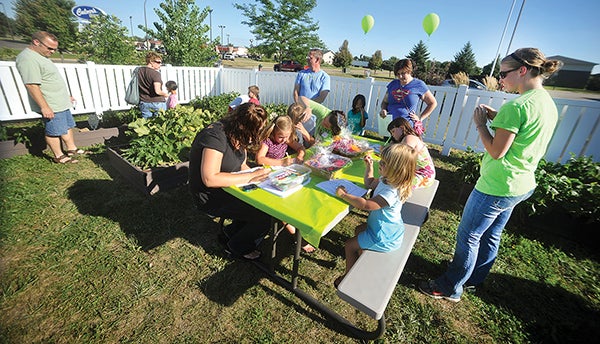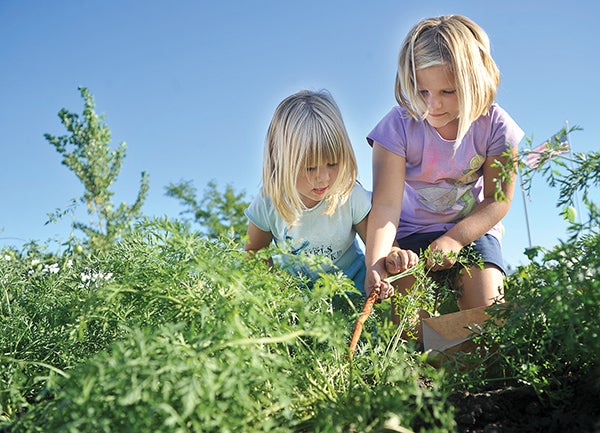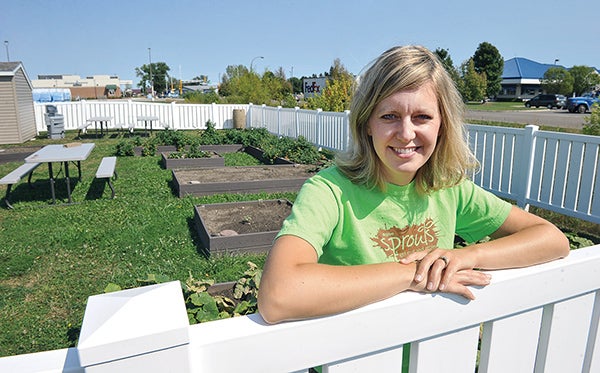The story of Sprouts
Published 5:15 am Thursday, April 11, 2013
Children’s garden grows to promote healthy lifestyles in eight states
—This feature originally appeared in Progress 2013. Get a copy at the Austin Daily Herald office, 310 Second St. NE.
To Jen Haugen, the idea to form Sprouts was natural: Children grow food, they learn about food and they eat food.
The dietitian debuted Sprouts: Get Out and Grow at Austin’s Hy-Vee in 2011 to expose children to gardening and healthy home-grown foods, and to expand their palates and improve their eating habits.
In its first year, the program was successful enough in Austin to attract the attention of corporate officials, who later decided to implement the program at many other Hy-Vee locations.
“It just kind of was like a small snowball that started to grow as it rolled down the hill,” Haugen said. “More people just got excited about it because they saw how it was working here, and it was really successful.”
In its second year, similar community gardens started at about 40 Hy-Vee stores across eight states, most using Haugen’s lesson plans and template.
That commitment isn’t waning as Sprouts nears its third year in Austin. While some may find a dietitian and community garden unconventional for a grocery store, store manager Todd Hepler said the business has a responsibility to help customers be healthy and live longer.
“[Haugen] is probably one of the most important people in our store,” Hepler said, noting he once sought Haugen’s help to change his diet and lower his cholesterol.
An idea sprouts
The idea for Sprouts dates to when Haugen, a Minnesota State University, Mankato graduate, worked as dietitian at the Mayo Clinic in Rochester. To Haugen, the idea hit close to home.
“I’ve always been around gardening through my parents, my grandparents,” she said. “And I after I got married, we had a garden. It’s just something we always did.”
When Haugen interviewed for Hy-Vee’s dietitian position in 2008, Hepler asked if she had a dream project.
“That’s when I said I would love to have a kids’ garden where kids learn how to grow their own food and what to do with it,” she said, noting she even envisioned the garden where it is now.
Haugen got the job and by 2010 began planning to make the project a reality. Originally, Haugen feared the project wouldn’t take off, and that it was just her brain-child.
“I felt like I was birthing another child,” Haugen said. “Because it’s this project that was mine, and I didn’t know if anyone else thought it was a good idea.”
Her co-workers would soon give her a vote of confidence. A few weeks before the first Sprouts, Haugen was working a long day to build the garden and a fence to enclose it when she took a break. She returned to find many Hy-Vee employees building the fence.
“It really just brought me to tears,” she said. “I was like, ‘They do believe in me. They do think this is a good idea.’”
Learning through the senses
In the first year, Haugen planted six vegetables, as Sprouts kicked off as a hands-on program. She said it was important for children to explore the food.
“There’s lots of research that shows when the kids are involved with gardening and cooking their own food they’re more likely to eat it,” Haugen said.
Over 10 weeks from June to August, about 80 children from Kids Korner and the Austin YMCA took turns going to Sprouts.
The children would learn food doesn’t come off a grocery shelf. They’ve learned how it grows, how it’s cooked, and then they taste the food.
“It’s kind of a cool circle,” Haugen said.
Even after a successful first year, Haugen worried she wouldn’t be able to quantify Sprouts’ effect on children’s daily eating habits. But then Haugen sent a survey to parents and received overwhelmingly positive feedback, with all the parents saying they wanted their children to be in Sprouts again.
“I knew it would make a difference, but I didn’t know how I could show it until I got the parent survey done,” she said. “That just kind of gave me the chills.”
Sprouting success
The success of Sprouts did not go unnoticed.
Hepler said Haugen’s vision to help families and children eat better mirrored leaders’ goals at Hy-Vee’s corporate level. Some officials visited Austin’s garden, and Haugen later spoke to a group of store directors about Sprouts.
They liked what they saw, and they decided to employ Sprouts at other stores, with Haugen training other dietitians.
“I was just really amazed that something I thought of was going to be implemented in other places,” Haugen said. “It made me feel good. It made me feel valued.”
The second year of Sprouts saw changes in Austin, too. Haugen grew the garden to about 19 different items, including vegetables, herbs and sunflowers. The Salvation Army summer program joined Kids Korner and the Y, bringing the total to about 150 participants.
Haugen also added a key partner, The Hormel Institute, which sent leaders to Sprouts to teach children about how different foods affect cancer.
Growing forward
Even though Haugen’s lesson plans are now used at the other stores, she hasn’t changed her technique.
Hepler still sees the program as a definite positive for Hy-Vee.
“Anytime that you can take children and healthy eating and combine them, you’re going to win.” he said.
A few examples of what Hy-Vee Dietitian Jen Haugen teaches at Sprouts
Swiss Chard
• Swiss Chard is an excellent source of vitamins A, C and K, making it a powerful vegetable for the eyes, in preventing cancer and in bone formation.
• Grows quickly and can repeatedly be harvested. The children caught on quickly on how to harvest the large leaves.
• The leaf and the stalk are edible.
• Chard is a member of the beet family.
• Looks like a giant spinach leaf (and tastes like it, too).
• Can be eaten cooked or raw.
• The leaves make good additions to salad, or cooked can add to soups and stews, or pizza. The stalk can be used like celery.
• The children prepared it in cheese quesadillas – they loved eating them.
• The kids prepared it as a salad along with strawberries and cantaloupe as a topping.
• By the end of the season, the children rated Swiss Chard as their favorite vegetable. And throughout the summer, they were able to take some leaves home, along with the recipes, to enjoy with their family.
Tomatoes
• They planted the Burpee Boost variety of cherry tomatoes called “Cherry Punch.”
• These tomatoes boast a 30 percent higher vitamin C and 40 percent higher lycopene content compared to regular tomatoes.
• Lycopene has a strong connection to preventing cancer and during the season, The Hormel Institute played a “mix and match antioxidants” game with the children to help them learn more about which antioxidants came from which plant.
• The children planted these tomatoes in early May of 2012, and by the first class in early June, they were already producing red tomatoes that could be harvested that day.
• The children were able to harvest frequently for use in recipes in class, as well as some for home. In fact, up to 700 cherry tomatoes were taken off the vines each week.
• From all ages, this tomato frequently was given a five-plus star rating for flavor, they were sweet and juicy, similar to a grape.
• The recipes the children made with these tomatoes included fresh garden salsa and pizza toast.
Basil
• Basil is a good source of essential oils, which act like antioxidants in fighting inflammation.
• During class, the children explored the herb with all five of their senses. The children were surprised to know how much this herb reminded them of pizza and spaghetti.
• Because basil is so easy to grow, the children were amazed each week at how quickly it gained height. They were able to harvest the basil almost weekly, using the leaves for various dishes, including pasta salad, rainbow wraps and pesto sauce.
• They had an herb area of the garden where various herbs were featured, and by the end of the season, the children were able to identify each of the five herbs.
Jen Haugen
Founder of Sprouts
Age: 34
Town: Austin
Job: Hy-Vee dietitian
Fun fact: In high school, Haugen wanted to be an accountant, but she job-shadowed her aunt, Peggy Saxton, an outpatient dietitian in Worthington, and decided to follow her lead.








